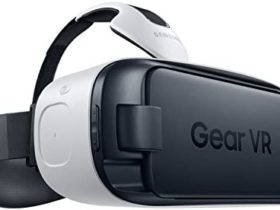There are many different definitions of VR, most of which agree on fundamental points. Today, when we talk about virtual reality (VR), we primarily mean computer-generated images and hardware created to immerse us in those sights and sounds.
Virtual reality must also be interactive, according to many definitions. Because of this, it would stand out from “see but don’t touch” media like 3D movies, 360-degree videos, and related content. The issue with this is that while a lot of computer-generated VR isn’t at all interactive, everyone still refers to it as VR. Despite not being computer generated, 360-degree video is functionally identical to a planned, non-interactive CG VR experience.
The first VR Head Mounted Display introduced in 1960
The Telesphere Mask by Morton Heilig, patented in 1960, was the first head-mounted display (HMD), albeit for a non-interactive film format without motion tracking. The headset offered stereo sound, broad vision, and stereoscopic 3D.
1961 First motion-tracking HMD, Headset
Two engineers from Philco Corporation named Comeau and Bryan created the headset in 1961, which was the first prototype of the modern HMD. It included a magnetic motion tracking device connected to a closed circuit camera, as well as a visual screen for each eye.
The headset was created to allow for immersive remote viewing of hazardous circumstances by the military, not for virtual reality applications (the phrase didn’t exist at the time). The user might glance around naturally by turning their head to operate a remote camera. The development of the VR helmet-mounted display began with Headlight, but it lacked computer and image-generating integration.
1965: Ivan Sutherland’s supreme performance
Ivan Sutherland talked about the idea of the “Ultimate Display,” which could imitate reality so closely that it would be impossible to tell it apart from the real thing. His proposal comprised:
- Enhanced 3D sound and tactile input created a virtual environment that could be experienced through a head-mounted display and seemed realistic.
- Computer gear to build and manage the virtual world in real-time.
- The capability for people to interact with virtual items in a realistic manner
Furness’ Flight Sim from 1966
Thomas Furness, a military engineer, is credited with sparking the advancement of contemporary flight simulator technology. His work in Human Interface Technology, which has led to him being referred to as “the grandfather of VR,” continues to influence VR technology today.
Sword of Damocles: 1968
The first VR/AR head-mounted display that was connected to a computer rather than a camera was developed in 1968 by Ivan Sutherland and his student Bob Sproull. It was called the Sword of Damocles. It was a huge, ominous-looking device dangling from the ceiling, too hefty for any wearer to wear comfortably. Additionally, the user would have to be secured inside the apparatus. Very basic wireframe rooms and objects made up the computer-generated graphics.
Artificial Reality Debuts in 1969
A virtual reality computer artist named Myron Krueger created a series of “artificial reality” experiences in 1969 in which he created computer-generated environments that responded to the people within them. His study progressed through the projects GLOW FLOW, METAPLAY, and PSYCHIC SPACE, which eventually led to the creation of VIDEO PLACE technology. Despite being thousands of miles distant, this technology allowed people to speak with one another in a natural computer-generated environment.
GE creates a digital flight simulator in 1972.
A “computerized” flight simulator made by General Electric features three screens set up in a 180-degree orientation. Trainee pilots can feel completely immersed in the cockpit simulation thanks to the screens that surround it.
Krueger’s VIDEO PLACE, 1975
The first interactive VR system is generally recognized as the VIDEO PLACE. It could measure user position by combining CG, light projection, cameras, and screens. Since there was no headgear involved, it was more akin to an AR projection in modern terminology.
The MIT Movie Map, 1977
The Movie Map is made by MIT. Through this system, users could explore a virtual representation of Aspen, Colorado. It resembled a prehistoric version of Google Street View. To give the appearance that they were driving through the city, they used a video that was captured by a moving car. Once more, this arrangement did not include an HMD.
McDonnell-Douglas HMD, 1979
Probably the first legitimate VR HMD outside of a lab is the VITAL helmet. Pilots could view crude computer-generated graphics using a head tracker.
Sayre Gloves was created in 1982 by Thomas DeFanti and Daniel Sandin as finger-tracking VR gloves. The gloves used optical sensors to track finger movement and were attached to a computer system. This served as a prototype for the “data gloves” that would later play a significant role in early VR.
In 1985, VPL Research is Founded
VPL Research was founded by VR pioneers Jaron Lanier and Thomas Zimmerman. This is the first time a VR company has ever sold gloves and HMDs. Their DataGlove product is where the phrase “data glove” originated.
Furness Creates the Super Cockpit in 1986
The “super cockpit,” a project of the Air Force, was directed by Tom Furness. It was a training simulator with real-time interaction for pilots and computer-generated images. It was interesting to see how movement monitoring and airplane control were integrated into the Super Cockpit.
1987 – The term “virtual reality” was coined
Virtual reality has advanced significantly, but there is currently no universal title to encompass the discipline. All of this changed in 1987 when Jaron Lanier, the creator of the Visual Programming Lab (VPL), created (or, in some people’s opinions, popularized) the phrase “virtual reality.”
The area under study now had a name. Jaron created a variety of virtual reality accessories through his firm VPL research, including the Dataglove (in collaboration with Tom Zimmerman) and the EyePhone helmet-mounted display. They were the first business to sell virtual reality gloves ($9000) and goggles (EyePhone 1 $9400; EyePhone HRX $49,000). a significant advancement in virtual reality haptics.
NASA Enters VR in 1989
Project VIEW is developed by NASA with assistance from Crystal River Engineering. an astronaut training VR simulator. VIEW sports gloves for fine-tuning touch interface simulation and has a recognized appearance as a contemporary VR exemplar. It’s interesting to note that the technology used in these gloves immediately inspired Nintendo to develop the Power Glove.
Virtuality Group Arcade Machines, 1991.
Although homeownership of cutting-edge virtual reality was still a long way off, the public started to have access to virtual reality gadgets. The Virtuality Group introduced several arcade games and equipment. Players would use VR goggles and gaming systems with real-time immersive stereoscopic 3D images (less than 50ms latency). For a multiplayer gaming experience, some units were also networked.
1991: The VR Mars Rover from Medina
We are accustomed to watching live videos from Mars rovers these days. This was still a far-off dream in 1991, and there were still many issues to be resolved. A VR system created by NASA engineer Antonio Medina allows users to control a Mars rover while also accounting for time delays. “Computer Simulated Teleoperation” is the name of the system.
The Lawnmower Man, 1992
Virtual reality was made more popular by the movie The Lawnmower Man. The creator of virtual reality, Jaron Lanier, and his early laboratory days served as inspiration for some of it. Pierce Brosnan as Jaron, a scientist who treated a patient with mental illness via virtual reality treatment. The movie uses actual virtual reality technology from VPL research labs, and the director, Brett Leonard, acknowledged getting ideas from organizations like VPL.
SEGA announced new VR glasses in 1993.
The Sega VR headset for the Sega Genesis console was unveiled by Sega in 1993 at the Consumer Electronics Show. The wrap-around prototype glasses included LCD panels in the visor, stereo sound, and head tracking. Sega had every intention of selling the device for around $200 at the time or $322 in 2015 dollars. Despite having created four games for this product, technological development issues meant that the device would always be in the prototype stage. Sega suffered a severe loss with this.
Sega VR-1 released in 1994
Sega continues to roll out VR gadgets, including the VR-1, a motion simulator arcade game that moves in sync with the action on the screen. It is similar to the AS-1 in this way, except the VR makes use of a head-mounted display while the AS-1 uses a standard projection screen.
Nintendo Virtual Boy, 1995
The Nintendo Virtual Boy, sometimes known as the VR-32, was marketed as the first portable device capable of displaying real 3D visuals. Despite price reductions after its initial $180 introduction in Japan and North America, it was a commercial disaster. The games were only available in red and black, there was little software support, and it was challenging to use the console in a comfortable position, according to the claimed causes for this failure. The following year, they stopped making and selling it.
1997 – Significant VR Treatment for PTSD
Working together, Georgia Tech and Emory University are using virtual reality to help combat veterans with PTSD. This remains a key component of current PTSD treatment and study. To effectively treat the symptoms of PTSD, controlled exposure to traumatic triggers is essential. With the use of virtual reality technology, therapists now have unmatched control over what patients see and feel.
2001: The Matrix
The Matrix, a movie by the Wachowski twins, premieres in theatres in 1999. Many of the movie’s protagonists are utterly oblivious that they are living in a world that has been thoroughly manufactured. Although some earlier movies, such as Tron in 1982 and Lawnmower Man in 1992, experimented with presenting virtual reality, The Matrix had a significant cultural impact and popularised the idea of simulated reality.
Google introduced Street View in 2007.
Street-level 360-degree photos were added by Google to its Maps service and were taken by special vehicles outfitted with specialized camera equipment. Utilizing a dodecahedral camera of their own design, Immersive Media completed the task. Thanks to this technology, you may now essentially “stand” anywhere in the world and take in your surroundings.
2010: The Oculus is prototyped, and Street View transitions to 3D
A few years later, Street View obtained a 3D version, but Palmer Lucky’s work is considerably more significant in the history of virtual reality. A chance encounter with computer legend John Carmack sets him on the path to making his “Oculus Rift” greater than he could have ever imagined. He has invented a kit of VR headgear that anyone can manufacture.
The Oculus Kickstarter in 2012
Palmer Lucky begins a Kickstarter campaign to raise money for his Rift prototype headset’s product and development. The campaign earns over 2.5 million dollars and serves as a stark contrast to the previous consumer VR commercial failures and the current VR boom.
Facebook purchased Oculus in 2014, and Sony revealed its VR initiative.
Social networking giant buys Oculus after recognizing the potential of its technology, making Lucky extremely wealthy. This year has been particularly fruitful with the introduction of Samsung Gear VR, PSVR, and Google Cardboard. Suddenly, virtual reality is a very popular subject.
Additionally, Sony said this year that they are developing a VR add-on for the well-known PS4 machine. Everyone is interested to see how they’ll manage since the PS4 is far less powerful than current-generation computers that support virtual reality.
All Hell Breaks Loose in 2016–2017
Everyone is releasing VR products this year that are ready for prime time. Although the HTC Vive and the Rift are at the forefront, the floodgates have really opened. Visit our HMD database to understand how this surge has affected the market.
2018: The announcement of the half-dome HMD
The “half dome” is a brand-new HMD prototype from Oculus. This cutting-edge headset has a 140-degree broad field of view and varifocal lenses.
2018: Mobile VR Dies, Standalone VR Rises
The Oculus Go and Oculus Quest are currently available. Two standalone VR examples that don’t require a computer or a phone to operate Mobile VR is gradually fading in popularity, while standalone devices like the Go are relatively reasonably priced.
VR Is Shifting Rapidly
Standalone VR headsets now include advanced technologies and mixed reality systems. Tethering support for the Oculus Quest is promised, and smartphone-based VR initiatives start to wind down.
VR headsets are now significantly less expensive, and computers that can operate them are almost universally available. A large number of cutting-edge headsets are coming. The main advancements include varifocal technology, extraordinarily broad fields of view, hand scanning, and eye tracking, to name just a few.
At this point, it appears that VR and mixed reality are likely to become inseparable in the future. Major corporations like Apple are rumored to be working on mixed reality projects.
If you are interested in more articles like this, here’s one about NFT Video Games: Everything a gamer should know about.











Leave a Reply